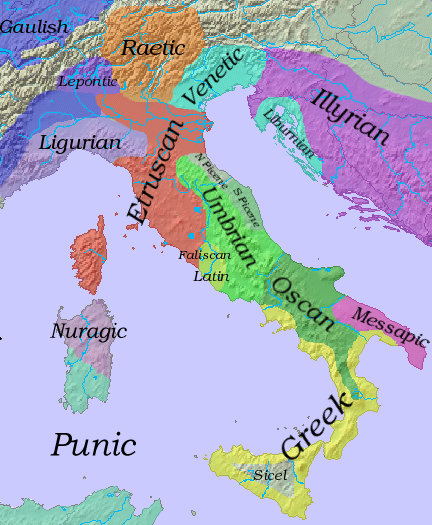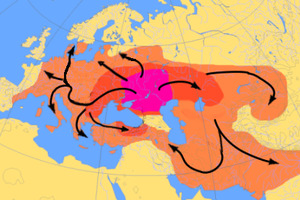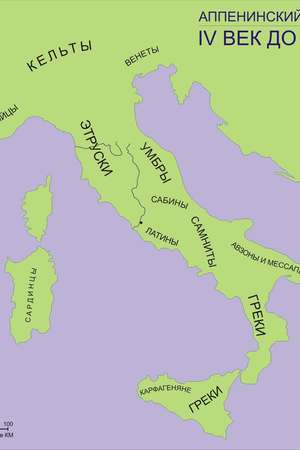Latins
Latins (Latin: Latini) were a people of the Italian group (Italic), whose language (Latin) was closely related to Faliscan and Siculian, and more distantly related to Sabine, Umbrian, and Oscan languages. They served as the basis for the formation of the Roman people and Romance peoples through Romanization. The historical area of residence is Latium.
 Latin peoples
Latin peoples
They appeared on the Apennine Peninsula at the beginning of the 2nd millennium BC in the territory of Ligurian settlement and gradually occupied the region of Central Italy, between the Tiber and Liris rivers (now Liri), which was named Latium (now Lazio) after them.
Scholars of the 19th-20th centuries [L. Pigorini (Italy), V. Helbig (Germany)] considered the Latins to be the bearers of archaeological cultures of the Bronze and Early Iron Ages, which came from the north through the Alps. Russian scholar V. I. Modestov distinguished Proto-Latins in the first major wave of Italics, creating the Terramare culture. Italian scholar of the 20th century M. Pallottino argued that the Latins did not penetrate simultaneously, but gradually, along with other Italics, in small groups through the Adriatic to Italy, where they separated from the other newcomers.
In the territory of Latium, in the Alban Hills, in Rome, and other places, the cremation ritual with a rather poor funerary inventory of the Bronze Age and round huts, as a variant of the Villanovan culture, were recorded. The Latins engaged in agriculture and herding, living in conditions of the decay of the primitive system. They also began to build fortifications of 30 primitive cities, which united at the beginning of the 1st millennium BC into the Latin League led by Alba Longa.
The Latins worshiped the same gods - Jupiter, Juno, Diana, Mars, and others, had common holidays, and gathered for common assemblies. In the late 6th - early 5th centuries BC, the northern group of Latins, that is, the Arician federation of 6 cities led by the city of Tusculum, was actively operating. It acted against Rome in alliance with the Etruscans and led the 1st Latin War (496-493 BC), which ended with the restoration of the alliance with the Romans on the basis of the equal Cassian treaty. In connection with the invasion of the Gauls (390 BC), the Latin League again disintegrated, but was later restored in 358 BC by a group of southern Latins.
First Latin War
First Latin War The First Latin War was an armed conflict between Rome and the cities of the Latin League in 499-496 BC.
The cause of the war was the dissatisfaction of the Latin communities with Rome's ambition for undisputed dominance in the Latin League. In addition, many in Latium were dissatisfied with Rome's aggressive policy. It was also known that Tarquinius Superbus, the last Roman king who was expelled from the city, participated in the war.
Around 501 BC, the ruler of Tusculum, Octavius Mamilius, "incited a conspiracy of thirty cities" of the Latin League. Presumably, it was after receiving news of this that the elections of the first dictator were held. A couple of years later, around 499 BC, military actions began: Fidenae was besieged, and Crustumeria and Praeneste were subjugated to Rome. Livy writes of the events of this year that "the Latin war, which had been smoldering for several years, could no longer be postponed." Soon the Battle of Lake Regillus took place, which became the main battle of the war.
In the battle, Tarquinius Superbus and at least one of his sons (Titus and possibly Sextus, who raped Lucretia) fought on the side of the Latins. The Latin army was commanded by Octavius Mamilius, Tarquin's son-in-law. The Romans were commanded by the dictator Aulus Postumius Albus Regillensis.
At first, the Latins managed to push back the Romans, so the latter soon began to retreat. However, the dictator ordered his elite cohort of guards to maintain formation and kill any fleeing Roman soldier. Later, the dictator ordered the cavalrymen to dismount and join the ranks of the infantry, after which the Latins began to retreat. During the battle, 6,000 prisoners were taken by the Romans.
All the military leaders personally participated in the battle. The chief of cavalry, Titus Herminius Aquilinus, clashed with Octavius Mamilius but was severely wounded and could not even hold a javelin in his hand, after which he was forced to leave the battlefield. Shortly thereafter, Titus Herminius breaks through to Octavius Mamilius and kills him, but in doing so receives a mortal wound. One of Tarquin's sons (probably Titus) was killed, and Tarquinius Superbus himself was wounded and forced to flee the battlefield. Marcus Valerius Publicola, the brother of Publius Valerius Publicola, also died in the battle - he tried to kill Tarquin's son for the glory of his family, which had expelled the Tarquins from Rome.
Around 495 BC, the Volsci, preparing for war with the Romans, sent ambassadors to Latium with a proposal to form an alliance against Rome, but the Latins handed the ambassadors over to Rome, for which a new treaty was concluded with them, and 6,000 prisoners were returned back. In gratitude, the Latins sent a golden crown to Jupiter Capitolinus.
Second Latin War
The Second Latin War was an armed conflict between the Roman Republic and the cities of the Latin League from 340 to 338 BC.
The cause of the war was the dissatisfaction of the Latin League communities with Rome's conquest policy and their dependent position on the latter.
In 358 BC, Latin tribes sent soldiers to assist Rome for the first time in a long time, fulfilling the terms of the Cassian Treaty, concluded after the First Latin War around 493 BC. However, already in 348 BC, at a meeting of representatives of the Latin tribes at the Ferentine Grove, the Latins, according to Livy, stated:
“Enough to command those whose help you need: with weapons in hand, it is more convenient for Latins to defend their freedom, not someone else's rule.”
The second half of the 340s passed in anticipation of war with the Latin tribes. In 340 BC, ten elders of the Latin tribes were invited to Rome. Upon arrival in Rome, one of the ambassadors, Annius, “spoke as if he was the victor, who captured the Capitol by force of arms, and not an ambassador, protected by the law of nations.” Annius, pointing to the regular military assistance provided to Rome, demanded on behalf of the Latin tribes that the Latins be recognized as part of a single people and a single state with the Romans, in which one of the two consuls would be elected from the Latins. Consul Titus Manlius Imperiosus Torquatus, fearing that the senators would accept the Latins' demands, categorically rejected their claims and called Jupiter as a witness to his righteousness, after which Annius, according to Livy, ran out of the Curia, stumbled, fell, and lost consciousness. This was interpreted as the support of the gods, after which the Romans assembled an army and began a military campaign.
According to the tradition preserved by Livy, shortly before the battle, the consuls had a prophetic dream, according to which victory was to be won by the army in which the commander "doomed the ranks of the enemy, and with them himself." After the auguries of the haruspices, the consuls decided that for the sake of common victory, the one whose front ranks (hastati) would start retreating to their second rank (principes) should end his life. Shortly thereafter, Consul Torquatus, who was maintaining strict discipline in the Roman army, ordered the execution of his son, who disobeyed the order and killed one of the Latins before the battle during reconnaissance.
The hastati of the left wing under the command of Decius were the first to retreat. Decius called the pontiff and under his guidance pronounced the sacrificial words, after which he threw himself into the center of the battle. Some time later, when the outcome of the battle was still unclear, Torquatus ordered the fresh triarii to join the battle, thanks to which the Romans won a complete victory.
Results
All Latin cities were developing towards poleis, and the success of the Roman polis in the 1st Samnite War (343-341 BC) led the Latins, who were competing with Rome, to the 2nd Latin War (340-338 BC), which ended with the formation of the Roman-Latin Federation under the rule of Rome. The Latins, having become Roman allies, retained self-government until the Julian municipal law (lex Julia municipalis, 2nd half of the 1st century BC), but lost independence in foreign policy and were obliged to supply soldiers to the Romans. Otherwise, their position differed: residents of a number of Latin cities (Tusculum, Praeneste) acquired full citizenship rights in Rome. But residents of others - received only property rights there, but with relocation to Rome - the fullness of the rights of Roman citizens (ius migrandi) and the opportunity to establish colonies together with Rome. This was the Latin right (ius Latini nominis), which distinguished the Latins from other allies of Rome and later extended to non-Latins.
The Romans and Latins, influenced by the Etruscans and Greeks, developed a distinctive culture based on the Latin language. In foreign and civil wars, the Latins, especially their upper classes, supported Rome. After the Social War (90-88 BC), the difference between the Latins and Romans finally disappeared.
Related topics
Roman Republic, Etruscans, Samnite Wars
Literature
- Peruzzi E. Aspetti culturali del Lazio primitivo. Firenze, 1978; Il Lazio antico: dalla protostoria all’età medio-repubblicana. Roma, 1986
- Mayak I. L. Interrelations of Rome and Italians in the III-II centuries BC (before the Gracchan movement). Moscow, 1971
- Nechay F. M. Rome and Italics. Minsk, 1963
- Modestov V. I. Introduction to Roman History. Questions of prehistoric ethnology and cultural influences in the pre-Roman era in Italy and the beginning of Rome. St. Petersburg, 1902-1904. Ch. 1-2; Nemirovskiy A. I. Istoriya rannego Rima i Italii [History of Early Rome and Italy]. Voronezh, 1962
- Titus Livy. History from the foundation of the city




